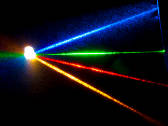The future of augmented-reality technology is here - as long as you're a rabbit. Bioengineers have placed the first contact lenses containing electronic displays into the eyes of rabbits as a first step on the way to proving they are safe for humans. The bunnies suffered no ill effects, the researchers say.
Device R&D
Space: Cash flow gives Xcor spaceplane momentum
Having cleared a critical cash hurdle, suborbital spaceflight aspirant Xcor is pressing ahead with spaceplane development in its bid to carry fare-paying passengers to the edge of space.
Toyota shows healthcare robots
Toyota has revealed a series of healthcare robots, including one to help people with a paralysed leg walk. The machines incorporate fast servos and sensors that detect posture and other subject attributes. Two of them use technology...
Sensor-laden dragonfly may help future robots soar
Researchers are using a microchip attached to a dragonfly's belly to understand the complex mechanics of its flight.
Space: Stalled Phobos probe may fall to Earth in January
The world's telescopes are still trying to contact a Russian space probe meant to visit the Martian moon Phobos, which has been stuck in Earth orbit since its launch on 8 November.
Thales, DCNS ready sea borne trials of unmanned rotorcraft
Thales and French naval defence systems specialist DCNS are readying sea borne trials of a system that promises world-beating accuracy for shipboard automated take-off and landing (ATOL) of unmanned rotorcraft.
Successful Soyuz launch saves ISS operations
Icy temperatures didn't stop the long-awaited launch of the first crewed Russian Soyuz rocket since all such missions were suspended following the crash of a cargo module in August.
DARPA solicits satellite air-launch proposals
DARPA has released a broad area announcement (BAA) calling for information about launching small satellites from aircraft as a low-cost alternative to expensive vertical rocket launches. The programme, called airborne launch assist space access (ALASA), calls for a range of modified carrier aircraft and custom-built rockets.
Science: Nuclear clock could steal atomic clock’s crown
Atomic clocks are the basis of GPS devices, they define the official length of the second and recently played a role in tracking subatomic particles that seemingly travelled faster than the speed of light. Now this "ultimate" timekeeper has a rival: a new method for making nuclear clocks suggests such devices could be 60 times as accurate as their atomic rivals.
Light your house with lasers
US researchers at Sandia National Labs have demonstrated that people are comfortable with viewing objects lit by four coloured lasers - blue, red, green, and yellow - instead of white LEDs or light bulbs. Lasers are extremely...
 Electronics Weekly Electronics Design & Components Tech News
Electronics Weekly Electronics Design & Components Tech News


